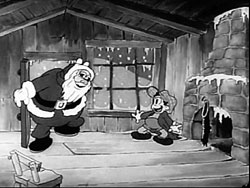 The Shanty Where Santy Claus Lives (1933) was originally in black & white Merrie Melodies cartoon.
The Shanty Where Santy Claus Lives (1933) was originally in black & white Merrie Melodies cartoon.
A colorized version is in wide circulation. The story takes some of its cues from Hans Christian Anderson's "Little Match Girl," except its Depression Era fantasy of wealth did not require the child to die.
An orphaned street urchin wearing a raggedy grown man's coat that drags the ground, sniffling unhappily, trudges through the snow past the church where happy people sing "Silent Night."
He presses on through the wind & snow, lingering outside the window of a lovely house wherein children dance around their Christmas tree.
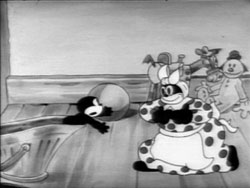 He arrives at an empty hovel in which he lives alone & immediately checks the stocking he hung over the cold, cold fireplace, for he hasn't any firewood. There's nothing in his sock, & he begins to weep. He arrives at an empty hovel in which he lives alone & immediately checks the stocking he hung over the cold, cold fireplace, for he hasn't any firewood. There's nothing in his sock, & he begins to weep.
All of a sudden, Santa Claus shows up, singing "The Shanty Where Santy Claus Lives," a song composed by Harry M. Woods who wrote such hits as "Try a Little Tenderness," "Side by Side," & "When the Red Red Robin Comes Bob Bob Bobbin' Along."
It's a weak song on its own, which is why you've never heard "The Shanty Where Santy Claus Lived" adapted to December selections of elevator music.
It perfectly fits the present story, at least, beginning with the lyrics: "They're making toys for little girls & boys/ In the Shanty where Santy Claus lives/ They're taking tears & turn them into joys? In the Shanty where Santy Claus lives..."
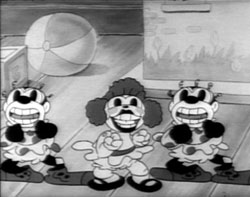 Santa lets the orphan hop aboard the sleigh & they head off to the shanty where Santy lives. Santa lets the orphan hop aboard the sleigh & they head off to the shanty where Santy lives.
The lad is greeted by living toys & begins to play with various things, including the same race-stereotype wind-up "Sambo Jazz Band" seen in two-strip Technicolor in Toyland Broadcast (1934).
Rudy Ising frequently re-used footage to save money. With unfortunately more race-stereotype content, a singing trio of one white doll & two pikaninny dolls sing the Santy's Shanty song while a bead-doll dances, then the pickaninnies dance to a rhumba. Part of this was lifted from Red-Headed Baby (1931) in which the same singing trio were singing "Red-Headed Baby" instead of "The Shanty Where Santy Claus Lives."
In yet another race gag, a white doll falls in a coal shuttle & comes out a black-face boy greeted by a mammy-doll who looks like Aunt Jemima
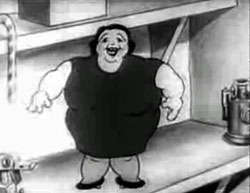 A little dolly is blowing up a balloon when the air backs up & she's inflated, to become a fat Kate Smith doll. She sings "Shine on Harvest Moon," while nearby, a teddy bear plays the trombone. A little dolly is blowing up a balloon when the air backs up & she's inflated, to become a fat Kate Smith doll. She sings "Shine on Harvest Moon," while nearby, a teddy bear plays the trombone.
For climax, a christmas tree catches fire & a toy fire department hurries to put it out, assisted by the orphan who fills a bagpipes with water & plays it all over the tree.
This cartoon was included as an extra on a dvd release of Lady Killer (1933), & is included in numerous compilation discs, notably Cartoon Crazys Christmas (1998).
This latter has a baker's dozen cartoons, not quite all of them actually about christmas. They are: Rudolf the Red-Nosed Reindeer (1944), A Waif's Welcome (1936), Fresh Hare (1942), Ginger Nutt's Christmas Circus (1949), Private Eye Popeye (1954), Santa's Surprise (1947), Hawaiian Birds (1936), Snow Foolin' (1949), Christmas Comes but Once a Year (1936), Tarts & Flowers (1950), & Christmas Night (1934).
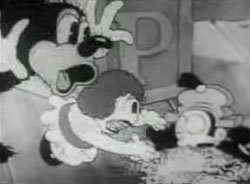 Another "Harman-Ising" Merrie Melodies cartoon, the aforemetioned Red-Headed Baby, is likewise about a toymaker's shop with toys that spring to life. Another "Harman-Ising" Merrie Melodies cartoon, the aforemetioned Red-Headed Baby, is likewise about a toymaker's shop with toys that spring to life.
As the toymaker has a long white beard & a hat not unlike Santa's, it could in fact be Santa's own workshop, especially as the cartoon had its theatrical debut on December 26th, 1931.
But the toymaker's identity is never explicitely given. We see ice & snow beyond his shop window, so we might assume the North Pole as location, or just a business street in winter.
When the clock strikes midnight (but shows one a.m.), the busy toymaker finally goes to bed. The doll he'd been working on springs to life & runs to the radio. Though it's a black & white cartoon, by the film's title we know the doll is red-haired, & she definitely looks rather red-haired.
As the radio plays jazz, we see the whole room is full of dancing toys. The red-haired baby sings in a Betty Boopish manner of a flapper, with the head toy soldier, Napoleon, joining in on the title song "Red-Headed Baby."
A giant spider with only six legs & a wind-up handle is the villain out to kidnap the toy soldier's beloved red-headed gal. Spider & Napoleon duel with sabers. Napoleon is disemboweled & falls apparently dead. The victorious spider runs off with the red head.
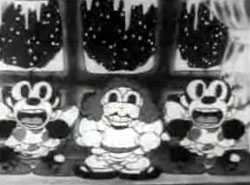 Napoleon recovers, though he's practically boneless, having "bled out" his stuffing. Napoleon recovers, though he's practically boneless, having "bled out" his stuffing.
He repairs himself in an odd way, inflating himself with steam. He then takes off after the fiend on a duck pull-toy. The spider is tormenting the red head on a speeding toy train., but soon overcome by Napoleon & other toys.
The red-head is joined by two pikaninny dolls (infamous stereotypes being tossed into such cartoons without a lick of social consciousness though such things were being criticized by the "Harlem intelligensia"). They stand in the icy window & reprise the title song.
When this singing trio was recycled into The Shanty Where Santy Claus Lives the following year, the cell animation drawings were superimposed on a different background, with some dancing added. A couple other scenes were also recycled into Shanty, including the bear with the tro,bone, & the first shot of the entire room full of dancing toys.
The toymaker awakens in his dancing bed to enjoy the show, ending the cartoon with a "Woopie!"
Really a delightful 'toon with a delightful tune by J. Fred Coots & Benny Davis. Coots wrote many great songs including "Santa Claus is Coming to Town" & now forgotten but an iconic hit for the Roaring Twenties, "Doin' the Raccoon." Davis wrote fine lyrics including for "(You've Got the Cutest Little) Baby Face," "Margie," & "Carolina Moon," & both wrote for Cab Calloway. So if the song "Red-Headed Baby" seems kind of great, it should.
This cartoon was included among extras with a dvd release of Cimmaron (1931) & can be found on compilation dvds of cartoons.
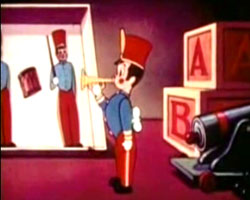 A Famous Studios "Screen Song" cartoon, Toys Will Be Toys (1949), featuring the tune "Oh You Beautiful Doll."
A Famous Studios "Screen Song" cartoon, Toys Will Be Toys (1949), featuring the tune "Oh You Beautiful Doll."
Beginning with a tootling version of "March of the Wooden Soldiers," all the soldiers come to life, & other toys join in the march, with lots of imagination & a few cinema references. Any number of these wind-up toys would be thrilling to possess.
The Queen of Toyland is a pretty dolly in a glassine-windowed box. The head toy soldier says we should all follow the bouncing ball & sing "Oh You Beautiful Doll" to her.
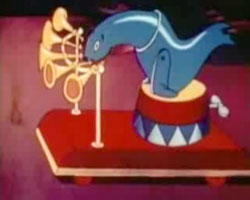 The next couple minutes are made up of lyrics against a heart or against small bits of animation, & a chorus singing the tune we can sing too if we're so inclined, just like karioke. The next couple minutes are made up of lyrics against a heart or against small bits of animation, & a chorus singing the tune we can sing too if we're so inclined, just like karioke.
As a theater audience was expected, the lyrics contain instructions for when all the boys, & all the girls, should sing separatel.
At the end of the tune, mice open up the box with the beauktiful doll & she gets kissed by the soldier.
Another Famous Stuidos "Screen Song" for the holidays is Snow Foolin' (1949), featuring the chestunt "Jingle Bells."
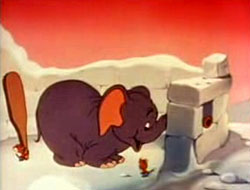 It's December 21, the first day of winter. A bunny comes out of his hollow tree & gets snow on his head. It's December 21, the first day of winter. A bunny comes out of his hollow tree & gets snow on his head.
A fox smells under his own armpits, but it's not him that smells, it's the skunk in his pyjamas. Some bullying cats are throwing snowballs at helpless mice, but they get an elephant to fire giant snowballs from its trunk at the cats.
Mommy & Daddy rabbits lead a big brood of bunnies skating on the frozen river. A penguin, a stork, & a centipede are also skating, & fish are skating upside-down on the underside of the lake's ice.
Many other animals parade by, one after another, with a number of amusign sight gags. The best is probably the kangaroo skiing off a jump-ramp while her infant in her stomach-pouch operates a hand-crank camera to document to jump.
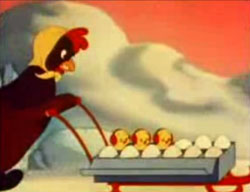 A mother hen happens by with her clutch of eggs in a baby-carriage. She's singing "Jingle Bells" as the chicks hatch one by one, already wearing ear-muffs as they pop out of the eggs. A mother hen happens by with her clutch of eggs in a baby-carriage. She's singing "Jingle Bells" as the chicks hatch one by one, already wearing ear-muffs as they pop out of the eggs.
The last egg of a dozen is slow to break open. While the egg hops up & down, the hen invites the theater audience to follow the bouncing egg (which she calls a "hen fruit") & sing the Christmas carol.
It's karioke time for the whole family, & an easy enough song that even the two-year-old might be able to join in, for the chorus at least. There are a lot more lyrics than anyone would know without the lyrics running along the screen.
THe song runs its course & we see at the end a turtle bringing hot coffee to a bird that didn't fly south for the winter because, she says, "At these prices, who could afford Florida."
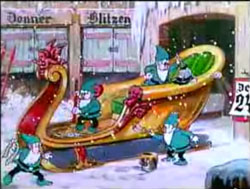 "Mickey Mouse Presents a Walt Disney Silly Symphony," from United Artists, namely Santa's Workshop (1932) in Technicolor. Despite that Mickey "presents," he's not even glimpsed in this episode.
"Mickey Mouse Presents a Walt Disney Silly Symphony," from United Artists, namely Santa's Workshop (1932) in Technicolor. Despite that Mickey "presents," he's not even glimpsed in this episode.
Ornate & prettily designed, we're shown the work & lifestyle of Santa & his elves in an extensive polar community. Everyone sings as they work, so-so tunes written for the cartoon, nothing so catchy as to be memorable.
As the elves labor on & on, Santa reads letters from kids, & whatever they ask for, if the list of naughty & nice, they get it. Those who've been naughty still get a little something, just not all the greedy things they ask for.
T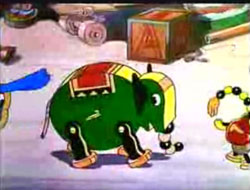 he laboring elves make rocking-horses on assembly lines, paint letters on blocks, measure dolls for costumes & set their hair. he laboring elves make rocking-horses on assembly lines, paint letters on blocks, measure dolls for costumes & set their hair.
One of the dolls is a pickaninny who says "Mammy!" instead of "Mah Mah," a racist joke that could be regarded innocuous or mild, except that such things occur way too often in cartoons of the period.
We see marching toy band & toy soldiers, marching wind-up penguins, pull-toy elephants, a Charlie Chaplin doll, many other things that walk, row, drive, or sommersault into Santa's bag. This parade is the cutest sequence in the cartoon.
For climax, Santa sings a little goodbye song in an operatic style & takes off in his reindeer-drawn sled into the sky. Not a lot original in this one, but it's bright, pretty, with loads of charm.
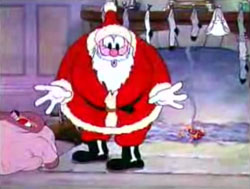 Once again "Mickey Mouse presents Walt Disney's Silly Symphony." The Night Before Christmas (1933) in Technicolor is partly structured around the famous poem, but is more of a "toys come to life" cartoon.
Once again "Mickey Mouse presents Walt Disney's Silly Symphony." The Night Before Christmas (1933) in Technicolor is partly structured around the famous poem, but is more of a "toys come to life" cartoon.
Generally Mickey's not actually in the Silly Symphony's he allegedly "presents," but he will be glimpsed in this one, for just a second, as a toy among the marching toys.
It starts with "Silent Night, Holy Night" behind the credits, wordlessly harmonized on the soundtrack. As soon as the cartoon proper starts, with an image of an idealized winter cottage, an Irish tenor is singing a bit of "The Night Before Christmas."
Inside the house we see a couple of scenes suited to the famous poem's lines, though the children in their bed number eight, all the same age, which is some trick for their mom, plus a ninth kid who is younger.
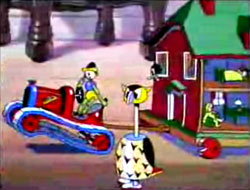 Meanwhile up in the sky Santa's sleigh is jingling along, lands on the cottage roof, & down the chimney goes he. In the living room he opens his tattered toy bag, toots a tiny horn, & a march of living toys proceeds as they take themselves from bag to the tree. Meanwhile up in the sky Santa's sleigh is jingling along, lands on the cottage roof, & down the chimney goes he. In the living room he opens his tattered toy bag, toots a tiny horn, & a march of living toys proceeds as they take themselves from bag to the tree.
The toys decorate the tree before settling down to become presents. It's exceedingly colorful; a toy blimp takes the star to the tree's very top.
All the toys dance to "Jingle Bells" & Santa joins in on a tiny piano, hitting a wrong note. The octuplets plus the toddler hear Santa laughing & come out on the landing, causing the toys to hurry to their spots never again to show life. The children rush down as Santa hops back up the chimney.
Junior opens his package & its a Scotty puppy lucky it didn't suffocate. The children line up in the window, with the puppy, & watch Santa flying off while the Irish tenor does one more verse. Not bad really!
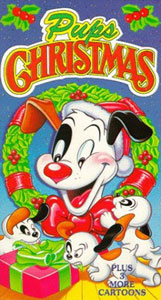 A "Happy Harmonies" cartoon from Hugh Harman & Rudolf Ising, cleverly joining their names to be a "Harman-Ising," The Pups' Christmas (1936) is pure cute.
A "Happy Harmonies" cartoon from Hugh Harman & Rudolf Ising, cleverly joining their names to be a "Harman-Ising," The Pups' Christmas (1936) is pure cute.
To "Silent Night, Holy Night" on the soundtrack played on an organ, three kids & their puppies are sneaking down the staircase to the living room, where the Christmas tree is beautifully decorated. This looks like a millionaire family's house.
The kids have high hopes for what is waiting for them under the tree. They wonder if Santa will have left something for the puppies too.
The two tiny dogs run around yapping while the kids unwrap toys & play with things. The pups get chased by a toy train, leap out of the way of a tricycle, but then find their own toys: A lovely doghouse & a toy fire hydrant.
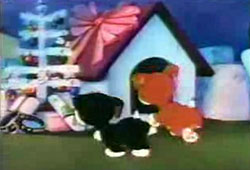 A big stuffed toy dog scares them. A wind-up army tank shoots scary sparks & leads to several little gags while "Over There" plays on the soundtrack, such wartime ingredients having been de rigour for the time. A big stuffed toy dog scares them. A wind-up army tank shoots scary sparks & leads to several little gags while "Over There" plays on the soundtrack, such wartime ingredients having been de rigour for the time.
One of the pups rips open a doll to get at the "momma" device, whiile the other continues to have mixed experiences with the tank. The tank gets quite aggressive & "kills" a climbing-monkey toy & ends up at war with a toy airplane, to neither toys' benefit.
Apart from the battle imagery typical of wartime cartoons, this essentially mimed cartoon with its cute pups would appeal to any little kids, including those who are not yet old enough to talk.
The Pups' Christmas was included in the compilation tape Pups' Christmas Plus 3 More Cartoons (1991). The other items are Teacher's Pest (1950), Jack Frost (1934), & Old Shell Game (1948). It's rather a short selection as such compilations go, & The Pups' Christmascan also be had in a number of larger compilations of vintage Christmas cartoons.
copyright © by Paghat the Ratgirl
|


 He arrives at an empty hovel in which he lives alone & immediately checks the stocking he hung over the cold, cold fireplace, for he hasn't any firewood. There's nothing in his sock, & he begins to weep.
He arrives at an empty hovel in which he lives alone & immediately checks the stocking he hung over the cold, cold fireplace, for he hasn't any firewood. There's nothing in his sock, & he begins to weep. Santa lets the orphan hop aboard the sleigh & they head off to the shanty where Santy lives.
Santa lets the orphan hop aboard the sleigh & they head off to the shanty where Santy lives. A little dolly is blowing up a balloon when the air backs up & she's inflated, to become a fat Kate Smith doll. She sings "Shine on Harvest Moon," while nearby, a teddy bear plays the trombone.
A little dolly is blowing up a balloon when the air backs up & she's inflated, to become a fat Kate Smith doll. She sings "Shine on Harvest Moon," while nearby, a teddy bear plays the trombone.
 Napoleon recovers, though he's practically boneless, having "bled out" his stuffing.
Napoleon recovers, though he's practically boneless, having "bled out" his stuffing.
 The next couple minutes are made up of lyrics against a heart or against small bits of animation, & a chorus singing the tune we can sing too if we're so inclined, just like karioke.
The next couple minutes are made up of lyrics against a heart or against small bits of animation, & a chorus singing the tune we can sing too if we're so inclined, just like karioke. It's December 21, the first day of winter. A bunny comes out of his hollow tree & gets snow on his head.
It's December 21, the first day of winter. A bunny comes out of his hollow tree & gets snow on his head. A mother hen happens by with her clutch of eggs in a baby-carriage. She's singing "Jingle Bells" as the chicks hatch one by one, already wearing ear-muffs as they pop out of the eggs.
A mother hen happens by with her clutch of eggs in a baby-carriage. She's singing "Jingle Bells" as the chicks hatch one by one, already wearing ear-muffs as they pop out of the eggs.
 he laboring elves make rocking-horses on assembly lines, paint letters on blocks, measure dolls for costumes & set their hair.
he laboring elves make rocking-horses on assembly lines, paint letters on blocks, measure dolls for costumes & set their hair.
 Meanwhile up in the sky Santa's sleigh is jingling along, lands on the cottage roof, & down the chimney goes he. In the living room he opens his tattered toy bag, toots a tiny horn, & a march of living toys proceeds as they take themselves from bag to the tree.
Meanwhile up in the sky Santa's sleigh is jingling along, lands on the cottage roof, & down the chimney goes he. In the living room he opens his tattered toy bag, toots a tiny horn, & a march of living toys proceeds as they take themselves from bag to the tree.
 A big stuffed toy dog scares them. A wind-up army tank shoots scary sparks & leads to several little gags while "Over There" plays on the soundtrack, such wartime ingredients having been de rigour for the time.
A big stuffed toy dog scares them. A wind-up army tank shoots scary sparks & leads to several little gags while "Over There" plays on the soundtrack, such wartime ingredients having been de rigour for the time.